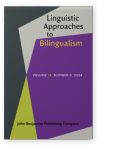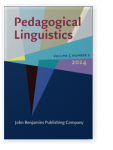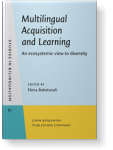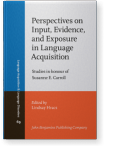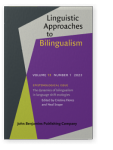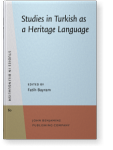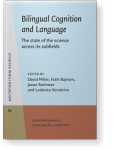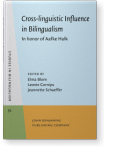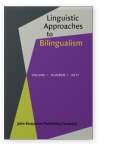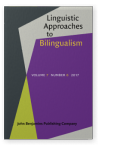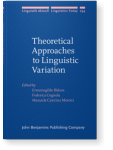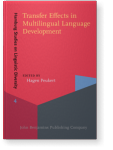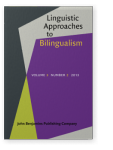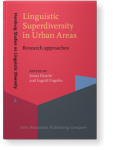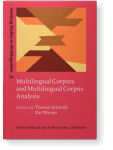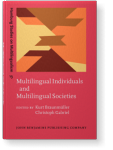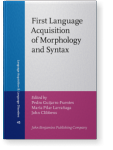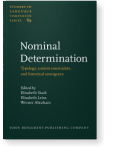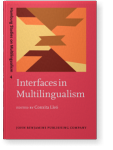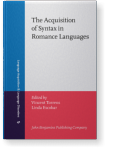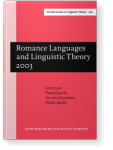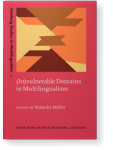Tanja Kupisch
List of John Benjamins publications for which Tanja Kupisch plays a role.
Journals
ISSN 2665-9581 | E-ISSN 2665-959X
Book series
Title
The Development of Grammar: Language acquisition and diachronic change. In honour of Jürgen M. Meisel
Edited by Esther Rinke and Tanja Kupisch
[Hamburg Studies on Multilingualism, 11] 2011. viii, 414 pp.
Subjects Historical linguistics | Language acquisition | Multilingualism | Syntax | Theoretical linguistics
2024 Development and initial validation of a yes/no vocabulary test for North Sámi: Drawing on item response theory and signal detection theory ITL - International Journal of Applied Linguistics: Online-First Articles | Article
This paper accounts for the development and initial validation of a yes/no vocabulary test of North Sámi called North Sámi Vocabulary Test (NSVT). North Sámi (NS) is an Indigenous language spoken in northern Scandinavia. Being an endangered language, NS is in need of revitalisation efforts. One… read more
2024 Chapter 4. Gender assignment in German as a heritage language in an English-speaking context: A case study of acquisition and maintenance Perspectives on Input, Evidence, and Exposure in Language Acquisition: Studies in honour of Susanne E. Carroll, Hracs, Lindsay (ed.), pp. 88–116 | Chapter
We present a case study of a heritage speaker of German, Luisa, who is growing up in an English-speaking part of Canada, focussing on the acquisition of grammatical gender in German. While German has cues to gender assignment, the acquisition of gender in this setting is compromised by the… read more
2024 Chapter 3. How does dyslexia impact second language acquisition? Insights from a questionnaire study with Italian and German learners of L2 English Multilingual Acquisition and Learning: An ecosystemic view to diversity, Babatsouli, Elena (ed.), pp. 90–115 | Chapter
This study compares the self-perception of first (L1) and second (L2) language competence and dyslexia awareness in two groups of dyslexic students, one German and one Italian, learning English as a second language. Based on a survey, we investigate the relationship between students’… read more
2023 Methodological challenges in working with Indigenous communities Epistemological issue: The dynamics of bilingualism in language shift ecologies, Flores, Cristina and Neal Snape (eds.), pp. 65–69 | Commentary
2020 Chapter 9. Perceived global accent in Turkish heritage speakers in Germany: The impact of exposure and use for early bilinguals Studies in Turkish as a Heritage Language, Bayram, Fatih (ed.), pp. 207–228 | Chapter
This chapter is concerned with Turkish heritage speakers (HSs) in Germany, here exemplified by 21 early bilinguals during adulthood who live in Hamburg, North Germany. We introduce the population, report their self-perceived proficiency and propose the Turkish Use Score (TUS) that is based on… read more
2019 The production of geminates in Italian-dominant bilinguals and heritage speakers of Italian Language, Interaction and Acquisition 10:2, pp. 177–203 | Article
This study examines cross-linguistic influence (CLI) in adult Italian-German bilinguals based on the production of gemination, a phenomenon that exists in Italian but not in German. We analyzed the spontaneous Italian speech of two groups of Italian-German bilinguals (heritage speakers of… read more
2018 Chapter 12. Different situations, similar outcomes: Heritage grammars across the lifespan Bilingual Cognition and Language: The state of the science across its subfields, Miller, David, Fatih Bayram, Jason Rothman and Ludovica Serratrice (eds.), pp. 251–280 | Chapter
The rise of scientific inquiry focusing on bilingualism over the past few decades has also borne witness to an increase in the study of individuals and communities who speak a native language that is not the sociolinguistically dominant language of the environment in which they grew up. While it is… read more
2017 Cross-lectal influence and gender marking in bilectal Venetan-Italian acquisition Cross-linguistic Influence in Bilingualism: In honor of Aafke Hulk, Blom, Elma, Leonie Cornips and Jeannette Schaeffer (eds.), pp. 127–152 | Chapter
We study dialectal influence and gender marking in 25 bilectal children and 11 adults speaking Italian and Venetan, based on an elicited production task (EPT) in each of the two varieties. The children are between 5 and 11 years old and vary with respect to their reported use of the dialect at home. read more
2017 Restrictions on definiteness in the grammars of German-Turkish heritage speakers Linguistic Approaches to Bilingualism 7:1, pp. 1–32 | To be specified
This paper reports on a study investigating restrictions on definiteness (the Definiteness Effect) in existential constructions in the two languages of Turkish heritage speakers in Germany. Turkish and German differ in how the Definiteness Effect plays out. Definite expressions in German may not… read more
2017 Transfer into L3 English: Global accent in German-dominant heritage speakers of Turkish Linguistic Approaches to Bilingualism 7:2, pp. 131–162 | Article
This study is concerned with L3 acquisition in heritage speakers (HSs). The goals are to incorporate HSs into L3 acquisition research and investigate the role of language dominance for predicting L3 transfer. We analyze global accent in German-Turkish early bilinguals, HSs of Turkish, who… read more
2016 Attrition at the interfaces in bilectal acquisition (Italian/Gallipolino) Theoretical Approaches to Linguistic Variation, Bidese, Ermenegildo, Federica Cognola and Manuela Caterina Moroni (eds.), pp. 295–316 | Article
The aim of this study is to investigate whether native speakers of Gallipolino, bilectals who have acquired Gallipolino as L1 (together with standard Italian) in their childhood, who have left Gallipoli after puberty and currently use standard Italian as their primary language, display effects of… read more
2015 Foreign accent in heritage speakers of Turkish in Germany Transfer Effects in Multilingual Language Development, Peukert, Hagen (ed.), pp. 87–108 | Article
The present study is concerned with global foreign accent (FA) in heritage speakers (HS). Specifically, we investigate whether (i) HS acquire a native accent in both languages and (ii) whether age of onset (AoO) is relevant. FA was examined in 21 adult HS of Turkish in Germany (AoO in German 0–9… read more
2013
This paper is concerned with gender marking in adult French. Four groups of subjects are compared: German-French simultaneous bilinguals (2L1ers) who grew up in France, German-French 2L1ers who grew up in Germany, advanced second language learners (L2ers) who are resident either in France or in… read more
2013 Foreign language acquisition in heritage speakers: The acquisition of articles in L3-English
by German-Turkish bilinguals Linguistic Superdiversity in Urban Areas: Research approaches, Duarte, Joana and Ingrid Gogolin (eds.), pp. 99–122 | Article
L3 acquisition has been a topic of increasing interest throughout the past decade. Nevertheless, linguistically-oriented work has so far paid little attention to the acquisition of foreign languages by second generation minority (or heritage) speakers, who have acquired two languages in early… read more
2012 The HABLA-corpus (German-French and German-Italian) Multilingual Corpora and Multilingual Corpus Analysis, Schmidt, Thomas and Kai Wörner (eds.), pp. 163–179 | Article
The HABLA-corpus (Hamburg Adult Bilingual LAnguage) comprises data in the form of semi-structured interviews gathered in the project E11, Linguistic Aspects of Language Attrition and Second Language Acquisition in adult bilinguals (German-French and German-Italian). E11 investigated the language of… read more
2012 Gender marking in L2 learners and Italian-German bilinguals with German as the weaker language Multilingual Individuals and Multilingual Societies, Braunmüller, Kurt and Christoph Gabriel (eds.), pp. 153–170 | Article
This paper explores mastery of grammatical gender in German as weaker and dominant language by Italian-German adult simultaneous bilingual speakers as well as highly proficient L2 learners of German with Italian as their L1. Data show that in both bilinguals and L2ers deviances from the target… read more
2012
In this paper we investigate whether learners of L2 English show knowledge of the Definiteness Effect (Milsark, 1977), which restricts definite expressions from appearing in the existential there-insertion construction. There are crosslinguistic differences in how restrictions on definiteness play… read more
2011 Introduction The Development of Grammar: Language acquisition and diachronic change, Rinke, Esther and Tanja Kupisch (eds.), pp. 1–15 | Introduction
2008 9. Dominance, mixing and cross-linguistic influence: On their relation in bilingual development First Language Acquisition of Morphology and Syntax: Perspectives across languages and learners, Guijarro-Fuentes, Pedro, María Pilar Larrañaga and John Clibbens (eds.), pp. 209–234 | Article
In this chapter I explore the relation between language dominance, mixed language utterances and cross-linguistic influence based on data from two German/French bilingual children. The children differ in terms of the extent to which one language can be considered dominant, but both produce fewer… read more
2007 The definite article in non-specific object noun phrases: Comparing French and Italian Nominal Determination: Typology, context constraints, and historical emergence, Stark, Elisabeth, Elisabeth Leiss and Werner Abraham (eds.), pp. 189–213 | Article
Italian allows for the use of the definite article in non-specific direct object NPs ( mettersi la giacca ‘put on a jacket’, avere il gatto ‘have a cat’). However, in French, the corresponding constructions typically take only the indefinite article ( se mettre un blouson, avoir un chat ). We… read more
2006 The emergence of article forms and functions in the language acquisition of a German-Italian bilingual child Interfaces in Multilingualism: Acquisition and representation, Lleó, Conxita (ed.), pp. 139–177 | Article
2006 Null arguments in monolingual children: A comparison of Italian and French The Acquisition of Syntax in Romance Languages, Torrens, Vincent and Linda Escobar (eds.), pp. 69–93 | Article
Research on the development of pronouns in French and Italian has shown that object clitics are acquired with more effort than other syntactic categories: they are realized later in development than subject clitics and strong subject and object pronouns. Both the delay of object clitics and the… read more
2005 Acceleration in Bilingual First Language Acquisition Romance Languages and Linguistic Theory 2003: Selected papers from ‘Going Romance’ 2003, Nijmegen, 20–22 November, Geerts, Twan, Ivo van Ginneken and Haike Jacobs (eds.), pp. 143–159 | Article
2003 The DP, a vulnerable domain? Evidence from the acquisition of French (In)vulnerable Domains in Multilingualism, Müller, Natascha (ed.), pp. 1–39 | Article
Recent studies have shown that the acquisition of determiners, and particularly articles, appears unproblematic for children whose target language is French. Examining the acquisition of C-related phenomena in Swedish and German, Platzack (2001) argues that the CP represents a vulnerable domain,… read more
